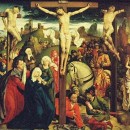Church Commemorates The Exaltation of the Cross

Today’s is a feast rich in history and in symbolism.
In symbolism, first: we know that the first Christians were so ashamed of the cross that it is never found among the first icons of the faith. For the cross, like a gallows, was ignoble, the punishment meted out to outcasts and slaves.
By contrast, Jesus is shown divine and resplendent - not human and broken. But God willed that this very instrument of shame should become our means of glory and redemption.
The allusion to the story of the bronze serpent in the book of Numbers is instructive. During their exile in the desert, God had punished the Israelis for their recalcitrance with an epidemic of snakes. Then, as the people writhed in pain and screamed to Moses for help, the prophet fashioned a serpent of bronze and placed it on a high pole in the midst of the camp. “All those who looked at it were saved. All those who only turned to their own wounds and fought with their snakes were doomed.”
This is the secret of the Bronze Serpent: whatever diminishes and destroys us has also the potential to heal and transform us. But for this, we must stop looking at ourselves alone and raise our eyes to the Man on the Cross. “For when I am lifted up on the cross, I will draw all to myself.”
And now for a bit of history: It was the empress Helena, mother of Constantine, who discovered the cross of Jesus amid the ruins of Jerusalem in 326. The basilica of the Holy Sepulchre was built here, and a relic of the True Cross was placed here for veneration.
When the Persian king Khushru invaded Jerusalem in 614, this relic was taken away; but about fifteen years later, the Christian emperor Heraclius defeated Khushru and restored the relic for veneration.
The feast of the exaltation dates from this time.
- 9220 reads
 Printer-friendly version
Printer-friendly version

